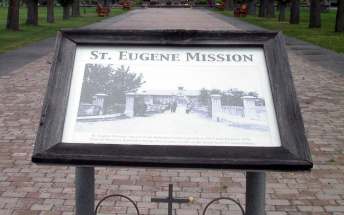Another dark reminder of most remarkable Canada Day
Read this article for free:
or
Already have an account? Log in here »
To continue reading, please subscribe:
Monthly Digital Subscription
$0 for the first 4 weeks*
- Enjoy unlimited reading on winnipegfreepress.com
- Read the E-Edition, our digital replica newspaper
- Access News Break, our award-winning app
- Play interactive puzzles
*No charge for 4 weeks then price increases to the regular rate of $19.00 plus GST every four weeks. Offer available to new and qualified returning subscribers only. Cancel any time.
Monthly Digital Subscription
$4.75/week*
- Enjoy unlimited reading on winnipegfreepress.com
- Read the E-Edition, our digital replica newspaper
- Access News Break, our award-winning app
- Play interactive puzzles
*Billed as $19 plus GST every four weeks. Cancel any time.
To continue reading, please subscribe:
Add Free Press access to your Brandon Sun subscription for only an additional
$1 for the first 4 weeks*
*Your next subscription payment will increase by $1.00 and you will be charged $16.99 plus GST for four weeks. After four weeks, your payment will increase to $23.99 plus GST every four weeks.
Read unlimited articles for free today:
or
Already have an account? Log in here »
Hey there, time traveller!
This article was published 30/06/2021 (1628 days ago), so information in it may no longer be current.
The community of ʔaq̓am, one of four bands in the Ktunaxa Nation, has announced a search employing ground-penetrating radar found 182 unmarked gravesites near the former St. Eugene’s Mission School.
The residential school outside the city of Cranbrook, B.C., run primarily by the Catholic Church between 1912 and 1970, instructed more than 5,000 children from the Ktunaxa, Okanagan, Shuswap, and Blackfoot nations.
A statement released Wednesday — the day before Canada Day — says: “It is believed that the remains of these 182 souls are from the member bands of the Ktunaxa Nation, neighbouring First Nations communities, and the community of ʔaq̓am.”
There is likely no way to know for sure. The records of these children — if such documents existed at all — have never been released by church leaders, government departments or whoever else was involved.
The school was well-known for having frequent, deadly outbreaks of influenza, mumps, measles, chicken pox, and tuberculosis — but also rampant abuse and violence, as well. It was a terrible place.
What is clear: school administrators didn’t care much to bury the children respectfully; many are in shallow graves.
Wednesday’s news brings the number to more than 1,300 unmarked graves at residential schools “discovered” in June — in places like Kamloops, B.C., Brandon, Regina, Lestock, Sask., and Cowessess First Nation (Sask.).
The Truth and Reconciliation Commission of Canada documented 3,201 deaths at residential schools, according to the records they were provided by governments and the churches. In one month, after searches led by First Nations, nearly one-third more have been found.
This means there are likely thousands more out there.
Without being too macabre, let’s do the math: if 182 of 5,000 children died at the St. Eugene school (and this is conservative), it is roughly four per cent of all students who attended.
That’s one out of every 25 students, roughly one per classroom.
Would you send your children to a school where one student in each class would die?
What if it was your daughter or son? How would the rest of the class feel having one of their members die?
What if school administrators didn’t care? What if they tried covering it up? What if there was rampant disease everywhere and the school day continued, uninterrupted?
What if media, politicians, and professors told you the school where your child died at “wasn’t all that bad” and “you should focus on the positive stories”?
What if those responsible for the deaths were never held accountable?
What if they had statues made in their honour, were called heroes, and buildings were named after them?
What if someone defaced one of those statues, refused to recognize them as a hero, or burnt down a building built in their honour?
What would you do?
Sitting with these difficult and complicated thoughts, feelings, and answers is what it’s like to experience Canada Day for an Indigenous person.
Canada Day is not a day to celebrate for us, but something we endure, often painfully.
Canada Day is not a day to celebrate for us, but something we endure, often painfully.
We are reminded amongst the songs, celebrations, and drunks dressed in red that our lands have been stolen, our children have been stolen and harmed, and most can’t speak our languages.
It’s a day impossible to celebrate but also difficult to cancel. For when we wake up, Canada will still be here, staring us in the face.
This is why our communities have always chose treaties and conversation over silence, beginnings over endings, and relationships over wars.
It’s hard to live in a place and with a people who have often chosen fireworks, flags and maple syrup over recognition, restitution and reconciliation. Amazingly, Indigenous peoples do it everyday — with grace, respect and kindness to others.
It has been in the hope, one day, this country would grow up and take responsibility for its atrocities.
On Canada Day, this country will have an opportunity like no other; to listen, learn and consider what actions will be necessary as a result.
On Canada Day, this country will have an opportunity like no other; to listen, learn and consider what actions will be necessary as a result.
Indigenous peoples have been talking for a very long time about all of these things.
Ironically, as the announcement at Cranbrook took place, 500 radio stations across Canada were participating in a 12-hour “A Day to Listen” initiative, featuring stories and songs by Indigenous leaders, musicians, educators, and residential school survivors. (All interviews are hosted on the Gord Downie & Chanie Wenjack Fund website.)
After you listen, the next actions will be up to you.
Sharing the land, teaching our children, and fighting to ensure no Indigenous people live in poverty, have children taken away or tainted water is a good start.
Enjoy what will be the most remarkable Canada Day in this country’s history.
niigaan.sinclair@freepress.mb.ca

Niigaan Sinclair is Anishinaabe and is a columnist at the Winnipeg Free Press.
Our newsroom depends on a growing audience of readers to power our journalism. If you are not a paid reader, please consider becoming a subscriber.
Our newsroom depends on its audience of readers to power our journalism. Thank you for your support.
















